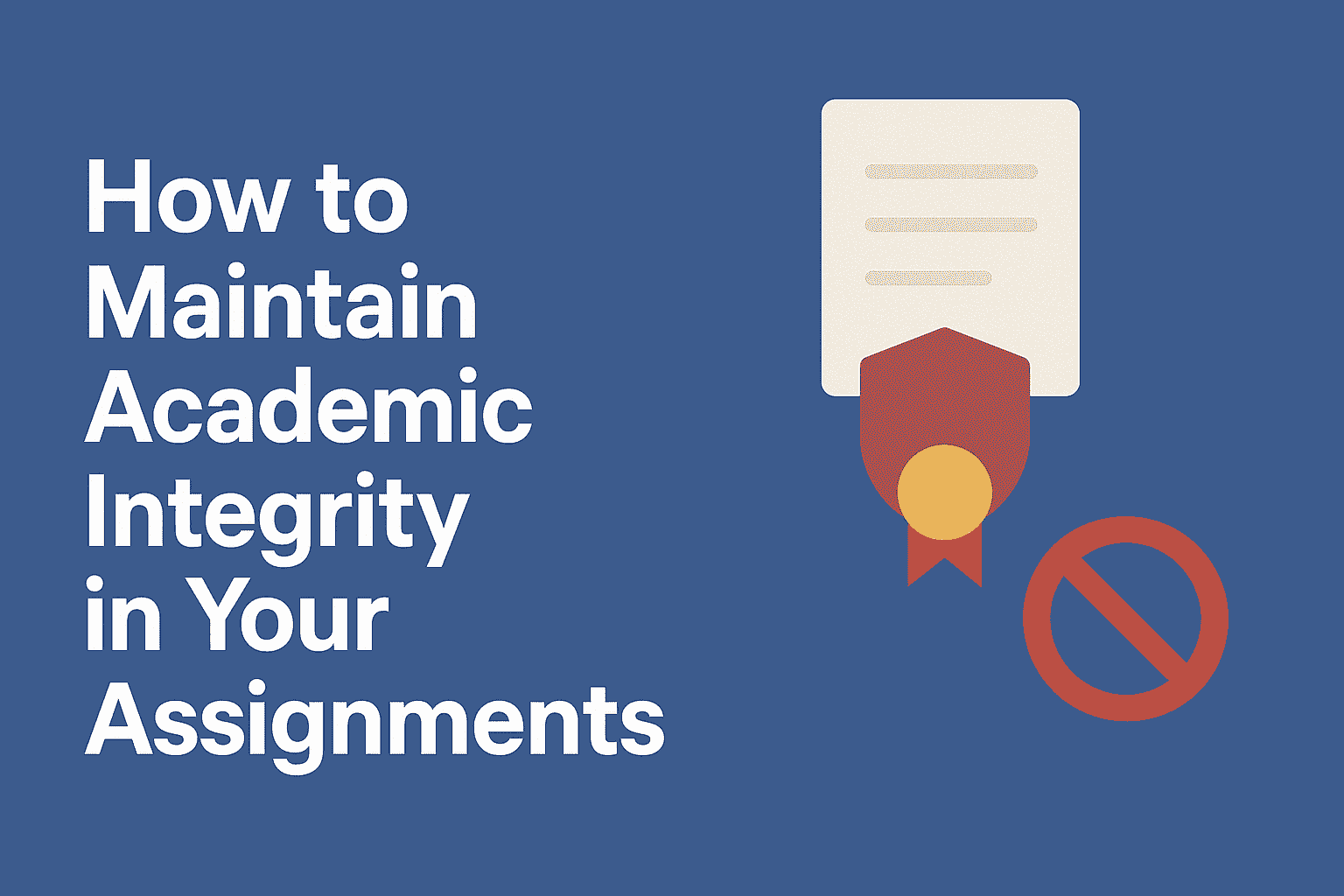How to Maintain Academic Integrity in Your Assignments
Academic integrity isn’t a checkbox. It’s a discipline, a mindset, and a responsibility that sits quietly behind every credible assignment. Students often talk about grades, deadlines, and stress. But integrity? That’s the piece many overlook. And that’s the most essential thing in academia. In fact, it’s the foundation of academia.
However, many students undermine it. And they have to face real consequences, including lower grades, failure, and expulsion. Do you want to maintain academic integrity? This guide can help. Let’s learn how you can ensure it with ease!
Understand What Constitutes Academic Dishonesty
To maintain integrity, you must first know what breaks it. Many think it’s all about plagiarism. It’s not confined to that. Here are some common examples of academic dishonesty:
Failing to cite properly, even unintentionally
Copying large sections and changing just a few words
Buying or downloading assignments online
Using AI without disclosure
Collaborating on restricted individual tasks
Submitting someone else’s work as your own
Misreporting lab results or data
Understanding these shades of misconduct is your first safeguard.
Develop a Clear Note-Taking Strategy
Bad notes are a liability. Many students often don’t take care of it. They just note down whatever they find helpful. However, when it comes to creating assignments, they add direct quotes without citations. This habit leads to accidental plagiarism in their work. To maintain academic integrity, make sure to avoid this practice.
Here’s a better approach for note-taking. Use three columns:
Direct Quotes (marked clearly with quotation marks and full source)
Paraphrased Ideas (in your own words, but still requiring citation)
Your Own Thoughts (clearly labeled)
That distinction is key to producing clean, citation-safe content. It also improves your critical thinking because you’re constantly distinguishing between reading and interpreting.
Stop Relying on Copy-Paste Methods
Copying and pasting with the intent to “fix it later” is a mistake. You might forget it later and miss the chance to ensure originality. And that oversight becomes a problem when your submission gets flagged for plagiarism.
Instead, write from scratch as much as possible. However, if you want to use something for reference, mark it clearly so you don’t forget to paraphrase it and add a citation.
Moreover, don’t rely on paraphrasing tools for rewriting. They might ruin your text and make it awful. And they don’t eliminate plagiarism. They just hide it behind clumsy paraphrasing.
Master Your Citation Styles
Using inaccurate citation styles can also lead to plagiarism and academic dishonesty. Remember, all citation styles have different rules. Make sure to understand them to avoid any mistakes. Also, before you write an assignment, read the particular style required for that.
Additionally, when you add citations, understand the pattern:
Who wrote it?
When was it published?
Where can it be found?
What type of source is it?
With those four answers, you can shape any citation manually, regardless of format. And if you’re unsure? Use your university’s style guide or official sources, not random blogs.
Keep a Source Log
While you research for an assignment, make sure to create a document and name it source log. In this document, create a list of all the sources you used for research. Moreover, include all the information about the sources, such as:
Full citation
Access date
Key ideas taken
Page or timestamp references
Notes about how you used it
This log helps you retrace your steps. It protects against accidental omissions. And if a professor ever asks, “Where did this come from?” you’ll have the answer.
Don’t Use AI Tools Without Disclosure
AI tools like ChatGPT, QuillBot, and Grammarly have made assignment creation much easier. And professors know that as well. Using them without transparency can breach institutional policies. Hiding your usage won’t protect you. Instead, it’ll expose you.
If you used AI to brainstorm, say it. If you paraphrased content using software, cite the original source. If you used AI to proofread, that’s often fine. But generating full paragraphs and submitting them as your own? That’s academic dishonesty.
Most institutions now define clear policies for AI-assisted work. Read them carefully, understand them, and follow them to maintain integrity.
Break the Assignment into Stages
Last-minute work invites shortcuts. And those shortcuts lead to sloppy citations and poorly paraphrased content. That’s how most students fall into plagiarism.
To avoid it, break your process into distinct stages:
Research (no writing)
Note-taking and organization
Drafting (based on notes only)
Citation checks
Editing and proofreading
Space them out across your deadline window. Ensuring integrity is always easier when you aren’t in panic mode.
Be Wary of Peer Sharing
Study groups are generally helpful. Similarly, collaborative learning also works. But boundaries matter. Don’t let a shared Google Doc turn into a copyfest. Don’t let peer “editing” become ghostwriting. And never agree to “swap” assignments for ideas. It’s not worth it.
If you’re unsure whether collaboration is allowed, ask your tutor. Every assignment has different rules. Sometimes, group input is encouraged. Other times, it’s prohibited. When in doubt, stay solo.
Use Plagiarism Checkers Early
Most students run plagiarism checks minutes before submission. That’s too late. Fixing flagged content takes time. If your rewording is poor, your grade takes a hit. And if you missed citations, even unintentionally, that’s still your responsibility.
Instead, check your draft halfway through writing. Then again, once it’s done. That’s how you’ll spot problems sooner and catch duplicate phrases.
Moreover, don’t rely on every random tool for that. Instead, always use a powerful online plagiarism checker to scan your work. Only it can find all instances of plagiarism and help you maintain integrity.
Ask for Help The Right Way
There’s a difference between getting help and getting someone else to do your work. But fear often keeps students silent. They don’t understand a concept, so they Google answers. They’re unsure about formatting, so they find a template online. The result? Patchwork content that fails the integrity test.
If you have any queries regarding the assignment, ask your professor, talk to your TA, or use your university’s writing center. For instance, if you need help understanding source material, say so. If you don’t know how to cite a government report, ask. There’s no shame in learning. There’s shame in stealing.
Avoid Reusing Old Work
Each assignment deserves fresh effort, new arguments, and updated references. If the topic overlaps with past work, cite your older paper and build on it. Make sure to expand, contrast, or reframe the ideas. But don’t recycle the same paragraphs and hope no one notices.
Professors have access to software programs that can quickly catch this effort. And they consider such tactics to be academic dishonesty. Remember, the purpose of education isn’t just output. It’s progress. So, don’t ever reuse your old work.
Stay Off Homework Marketplaces
There’s an entire ecosystem of academic fraud, including homework marketplaces, essay mills, and even Reddit forums where “helpers” write for money. They promise privacy and guarantee original work.
To mitigate the issue, many institutes are now tracking submission patterns. They flag mismatches in writing style, monitor logins, and geolocation. And when an essay looks suspiciously polished, instructors investigate. So, if you use any of these techniques, you might get caught as well.
Therefore, stay away from these platforms. They won’t protect you. Instead, they’ll ruin your reputation.
Proofread With a Critical Eye
Proofreading makes your assignments clear and effective. However, many just check grammar in the name of proofreading. It’s a wrong practice. Don’t just proofread for grammar. Proof for ethics. Ask:
Did I cite every idea that isn’t mine?
Did I blend my voice with sources or just copy?
Did I follow the assignment rules?
Did I use tools ethically?
A 10-minute ethical review can save you hours of future regret. Don’t assume you did everything right. Verify it.
Respect the Assignment Purpose
Every assignment has a reason. Some assess critical thinking. Some test research skills. And others push you to argue a position. When you don’t understand the purpose, your work becomes mechanical. That’s when students start padding word counts and inserting irrelevant citations.
If you’re unclear on the goal, read the guidelines carefully. Understanding what your professor wants makes you less likely to cut corners. That’s when you won’t write for length but write for impact and ensure integrity.
Final Thoughts
Academic integrity doesn’t happen by accident. It’s a choice you make with every draft, every citation, every source you touch. The shortcuts are tempting. But the consequences are brutal. So, protect your reputation, guard your learning, and earn your grades honestly.






